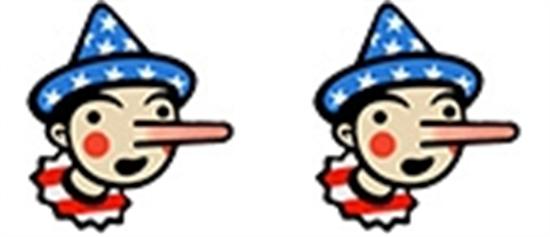In Case You Missed It
Washington Post: President Obama Earns Two Pinocchios for Misleading Energy Claims“While our criticism of the use of the statistics may have been convincing to many readers, the president has not dropped his language since we wrote our column; instead, he has repeated it at least four times…We hope he finally drops this specious logic from his talking points.”
WASHINGTON, D.C.,
March 22, 2012
|
Jill Strait, Spencer Pederson or Crystal Feldman
(202-225-2761)
Washington Post Fact Checker Last week we wrote about Obama’s dubious combination of two true statistics — the fact that the United States has 2 percent of proven oil reserves and accounts of 20 percent of annual oil consumption. We called these “non sequitur facts,” since they have little relationship to each other, and gave the president the rarely used “true but false” rating. We also said we would monitor the president’s use of these figures in the future. The column prompted more than 1,000 comments, and a number of readers wrote that we were too generous to the president. Here’s how one thoughtful reader put it in an e-mail: I think you hit the problem on the head — but I don’t think you go far enough in your comment: This is really a case of apples and oranges. The fact that the U.S. has 2 percent (or even if it were 50 percent) of proven reserves, and the fact that the U.S. consumes 20 percent of the worlds oil are totally unrelated. If the world’s oil reserves were 1 barrel, and the U.S. had 100 percent, we would still not have enough reserves, even if we only consumed 1/10 of 1 percent of the world’s oil. 1 barrel isn’t going very far. On the other hand, if the world’s oil reserves were 500-gazillion-katrillion-jillion barrels, maybe it could satisfy all the world’s demand for centuries, whether the US consumed 20 percent or 70 percent — so what. They are simply unrelated statistics. While our criticism of the use of the statistics may have been convincing to many readers, the president has not dropped his language since we wrote our column; instead, he has repeated it at least four times. In fact, in the speeches in Prince George’s County and in New Mexico, he made it worse. As we explained before, “proven oil reserves” has a very strict definition, in part because reserves are considered actual assets owned by companies. The oil must have been discovered, confirmed and economically recoverable, with at least 90 percent certainty. But in his Prince George’s speech, Obama claimed that even if “we went to your house and we went to the National Mall and we put up those rigs everywhere, we’d still have only 2 percent of the world’s known oil reserves.” In New Mexico, Obama declared, “even if we drilled every square inch of this country, we’d still only have 2 or 3 or 4 percent of the world’s known oil reserves.” That’s just simply wrong. The United States has the same number of barrels of proven oil reserves — 22 billion — today as it did in the 1940s. That’s because new sources of oil kept getting found, more-difficult-to-obtain oil suddenly became more economically viable, new oil-extraction techniques gained favor, and so forth. So, in light of the president’s statement in Prince George’s County (and in New Mexico), we are going to change our ruling to Two Pinocchios. The way he phrased it there, it certainly qualifies under our rating scale: “Some factual error may be involved but not necessarily. A politician can create a false, misleading impression by playing with words and using legalistic language that means little to ordinary people.” The president is on an energy tour this week, and on Wednesday he once again made this claim. We hope he finally drops this specious logic from his talking points. Two Pinocchios
### |
Newsletter Sign Up
Sign up to receive news, updates and insights directly to your inbox.


